Old News: This Week in 1988
In this week’s Old News, Managing Features Editor Sonia Chajet Wides ’25 sums up a 1988 edition of The Amherst Student — a time of new meal plans, record-breaking diversity rates, and purple ice cream — showing how an ’80s Amherst is different (and strikingly similar) to the school we know today.
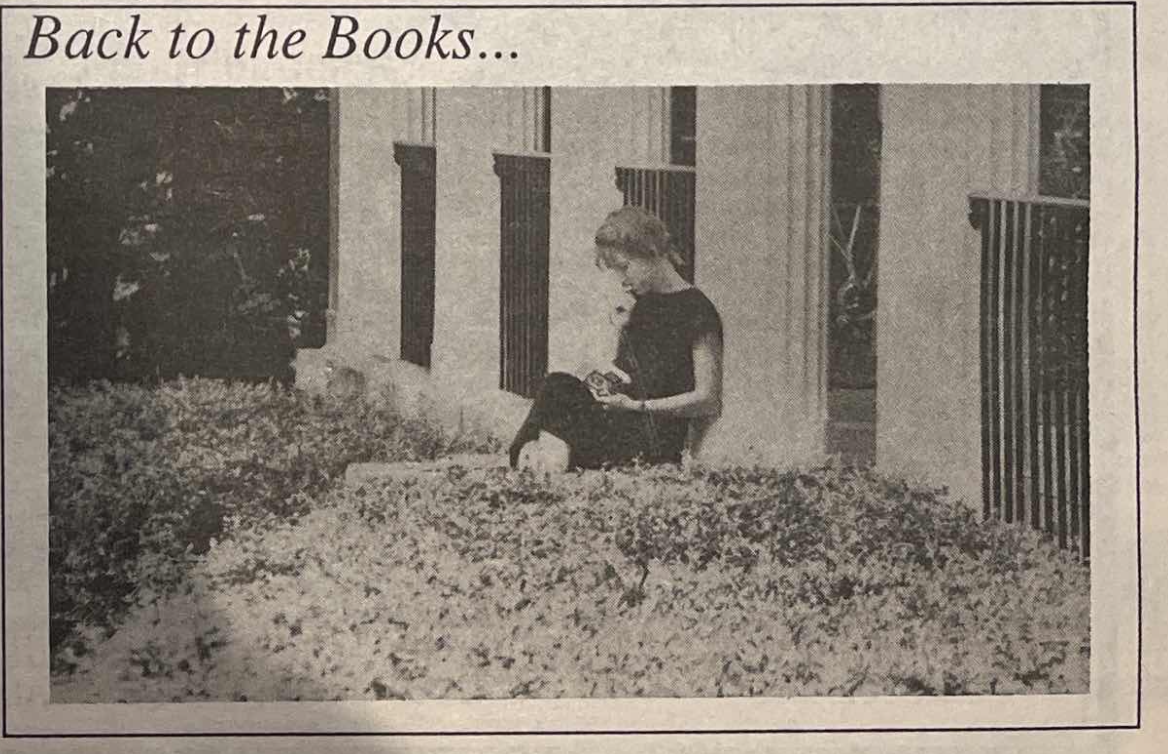
Welcome back to Old News! Each week, I use a random number generator to select a year in the college’s history, and take a look at The Student’s issue from this week in that year. My hope is to make our past feel more tangible, to help us understand this place a little better, and to explore the role of The Student in cataloging history. Read more about this project in my first column here.
This week’s year: 1988
This week’s edition of Old News takes us back 35 years, to Sept. 14, 1988. This issue of The Student contains glimpses of an Amherst similar to the one we all know now — it even includes a contribution from then-student, now-President Michael Elliott. Some of its stories are particularly relevant to these opening weeks of the semester: Like us, students in 1988 lamented long Val lines and even longer package lines. Updates to meal plans and campus smoking policies were new adjustments. And one student grappled with the loss of a tradition we’ve never had the pleasure of knowing: purple ice cream in Val.
A big headline was the celebration of the increased diversity of the incoming freshman class — still very low at only 24 percent students of color, but the highest that Amherst had yet seen. Articles attributed this increase to the efforts of the Office of Admission and student groups alike, as organizations like La Causa, Black Student Union (BSU), and Asian Student Association (ASA) had participated in outreach and recruiting for an inaugural admissions weekend the year before (now known as Access to Amherst or A2A). This old news felt particularly pertinent, and sobering, as we enter this year on the tail end of the Supreme Court’s decision to overturn the legality of affirmative action in college admissions, which has thrown into question Amherst’s decades-long work-in-progress to increase its racial diversity.
The Most Diverse Class To Date: An article proclaimed that the incoming class of 1992 had the largest percentage of students of color in the history of the college, and also that it was more socioeconomically and geographically diverse. Even though the numbers were a 10 percent increase over the previous class, they were still relatively bleak, especially as compared to now: 24 percent of the class (89 of 379) were “minority students.” The incoming class was about 7 percent Black, 7 percent Latinx/é, 9 percent Asian, and 0.5 percent Indigenous.
Associate Dean of Admission Leonard L. Satterwhite attributed this “success to the cumulative efforts of the admissions office … an increase in on-campus programs and the direct involvement of minority student groups at Amherst.” The previous year, more students and families had been involved in recruiting students, visiting high schools, and hosting students at the first of what was to become the A2A weekend, formerly the Diversity Open House (DIVOH), and at this point called the “Minority Weekend.”
Christiana Contopoulos ’91, a member of the La Causa student board, discussed a phone-a-thon conducted by La Causa and other student groups like the BSU and ASA, which reached out to high school students of color to let them know about the new admissions weekend, where students could fly to Amherst free of charge. Each of the student groups had a liaison for the weekend, and hosted and toured prospective students.
Many of the admissions strategies that the article describes are similar to ones that the college began using in the 1960s, when the Amherst’s diversification efforts really picked up. They are also similar to some of the admission office’s policies now. Fall 2023’s first-year class of 2027, by the college’s June report, is composed of 50 percent domestic students of color and 13 percent international students, statistics that can only hint at all the complex ways that Amherst’s diversity has increased and evolved.
But we also begin this academic year with seemingly endless questions about how the Supreme Court’s overturning of affirmative action policies will affect Amherst’s current and future efforts to diversify its student body. It is strange, and upsetting, to read these testimonies of hope and effort towards making the college community more diverse, in the wake of a decision that negated those efforts and casts doubt on their future legality.
At the time, though, there was much celebration and affirmation of the importance of this increasing diversity. Associate Dean of Students [Onawumi] Jean Moss was reportedly “pleased” by the increase in students of color and by the fact that 47 percent of that year’s class were women. “These two things combined … may be the best thing that could happen to Amherst,” Moss said, “It is my hope that their presence will call on the entire college community to take a look at the system in which we operate, and perhaps to make changes that will set Amherst ahead … as a liberal arts community.’” I’m thinking about Moss’ words as an affirmation of the importance of making higher education more equitable, as we look ahead to future efforts in this changing landscape.
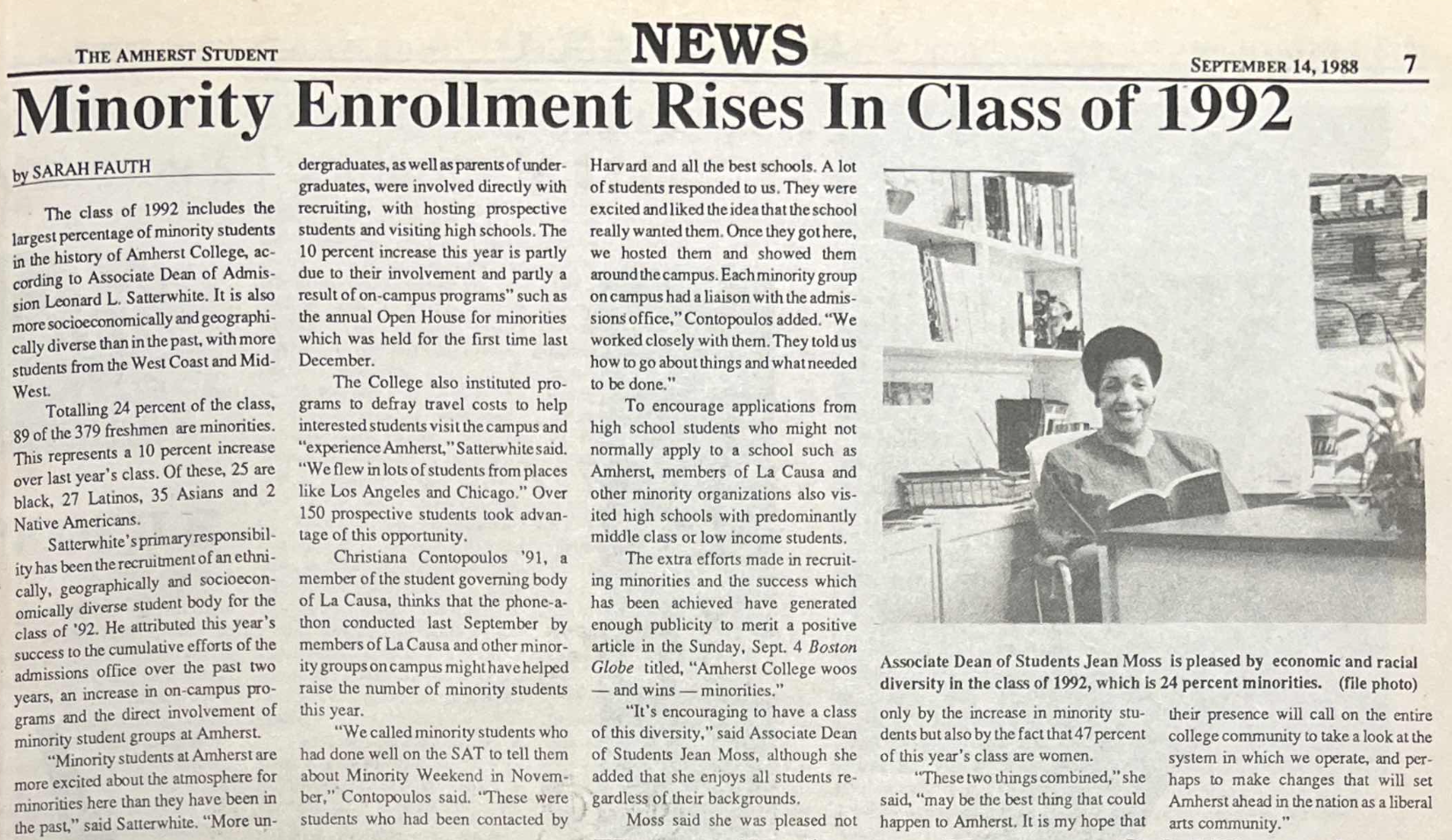
A New Computer Check-in System at Val: This week (in 2023), as Val cracks down on people forgetting their physical IDs, and people wait in the long back-to-school lines of the post-to-go-box era, we can recall that students felt similar frustrations 35 years ago. At the time, Val was switching to a computer card-checking system, with magnetic ID cards and a computer software system that cost $80,000. The change was made following student complaints about the lack of options and flexibility for meal plans; the new cards could be pre-loaded with money to charge snack bar food.
Some complained that the computerized system was the cause of long lines. Julian Haywood ’89 was quoted as saying “I don’t know what they’re going to do when winter comes along and we’re lining up along Route 9!” In an opinion piece, Susan Banki ’91 reported on the change: “Crowds of impatient and hungry students milled about, all newly equipped with their little radioactive cards.” Banki pointed out that the students themselves had asked for the new system, with most of them voting “yes” on the new system on a questionnaire the previous year. The administration said that the new system allowed for better records of meal plan usage, and was better at catching sneak-ins, visitors, and “even those careless enough to leave their meal cards at home.”
But the new system caused glitches and confusion; one experiment to address the crowds involved having checkers in each dining room, not just at the entrances. As Banki noted, “A picky eater who wanted veggie in East, cranberry juice in West, and a seat in Annex went through a hellish process in which she had to pull out her tacky blue card … three times.”
At the very least, the long waits offered the opportunity for reflection. “Students either wait patiently in winding lines or speak nostalgically about the good old days,” Banki wrote, “when the flash of a credit card gained you entrance to Valentine; when you dealt only with one long line per meal; when you could use your plain old plastic cards … and when the pictures weren’t so damn ugly.”
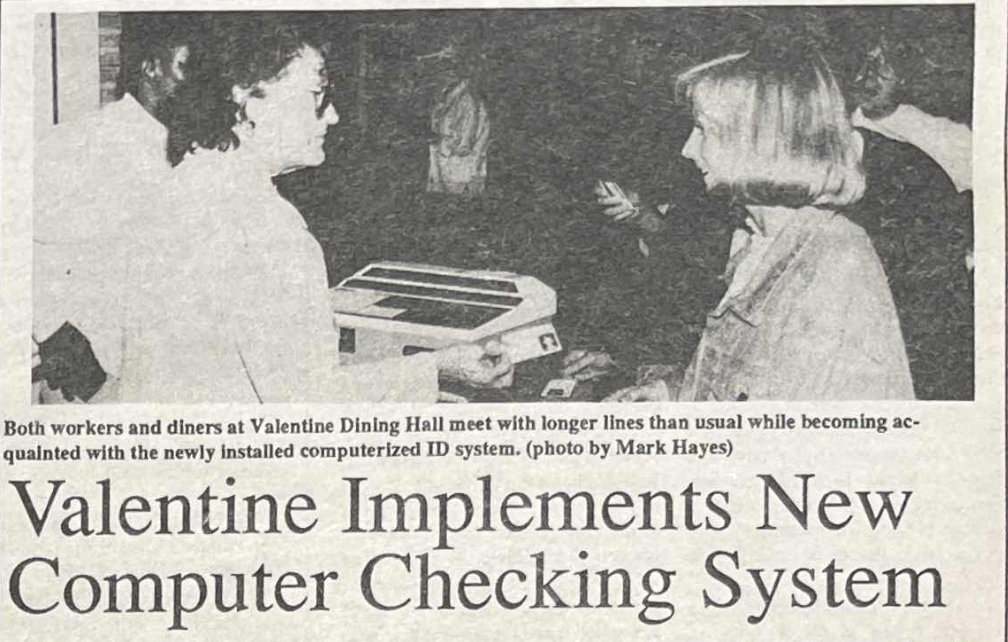
Campus Center’s New Smoking Policies: A new set of policies focused on the Campus Center (now Keefe Campus Center) was announced at the outset of the 1988-89 school year, as supported by the Campus Center Advisory Committee (CCAC). Among the changes: condom machines in restrooms, and a new smoking policy for the building. While “the remainder of campus has no established smoking policy,” the CCAC recommended that public areas in the campus center be segregated into smoking and non-smoking for at least a year “in response to numerous complaints from students and faculty last year.” No plans for enforcement of the policy were announced at the time because “administrators hope[d] that peer pressure will prove effective and sufficient.” It was the same approach the college took in 1976, when it banned cigarette smoking in West Val.
New (yet Familiar) Faculty: The front page of The Student reported that President Peter Pouncey had announced the appointment of 28 new faculty members. Among those appointed and quoted in the article were faculty members who still teach at Amherst today, such as Professor of German Christian Rogowski, who said that he was excited about working at Amherst because “the sense of people caring about what you’re doing.” Then an incoming professor, Professor of Asian Languages and Civilizations Wako Tawa pointed to the enthusiasm and dedication of Amherst students. Both Rogowski and Tawa also “noted that the Valley is a good region … for their children to live.”
“Camp and Frisbee: Do They Make for a Successful Orientation?”: One Features article explored other schools’ orientation traditions, like Yale’s student-planned orientation program and Williams’ pre-orientation hiking trips.
The article’s author? None other than one Michael Elliott ’92.

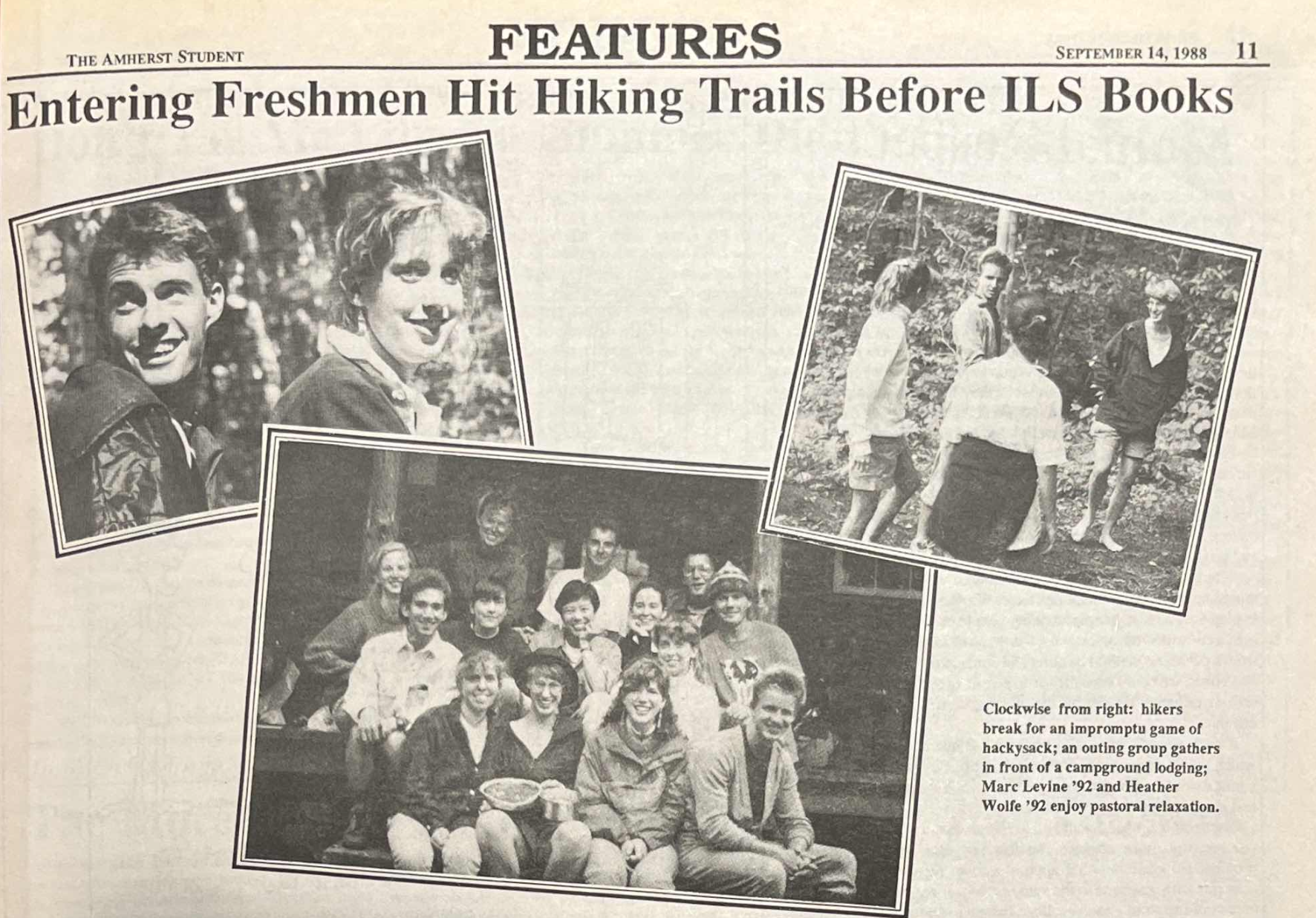
Cartoon Poking Fun at Naive Freshmen:
Many of these quotations may be echoed today — Like “What’s a Smudd?” But for those of us who were born in this century, ILS refers to “Introduction to Liberal Studies,” the predecessor of first-year seminars; TAPs were theme parties thrown by a social council.
New Police Station, Old Building: In 1988, the Amherst Police Department was about to start construction on what is now their current station at 109 Main Street, across the street from the hill home to Marsh House, Plimpton Dormitory, and Tyler Dormitory. At the time, the station’s construction was causing an uproar because it necessitated demolishing a historic building once home to Robert Frost, which in ’88 housed the offices of the Amherst Bulletin and the Daily Hampshire Gazette. Police Chief Donald Maia suggested that the college should purchase the older building and move it somewhere else on campus.
Apartheid Photography Exhibit in Frost: The Student announced the launch of a photography exhibition titled “Whites Only,” which contained photographs taken in South Africa by Mark Frier ’90, with 20 pictures depicting everyday scenes of apartheid in Cape Town. “‘Whites Only’ is a highly provocative exhibit, greatly due to its refusal to rely on shock value,” read the review in The Student. “The scenes and the people … are most effective because they could be taking place outside our own door.”
Humorous Campus Criticism: In one piece, titled “The More Things Change, The More They Stay The Same,” Jennifer Mathews ’91 documented some of the trials and tribulations of Amherst students in fall 1988. Many echo current conditions.
“The mailroom is the same,” Matthews wrote. “First you have to remember your combination, which is slightly less work than the Econ 11 final. When you eventually get your box open, you find it stuffed with the following: 37 all-campus mailings, none of which seem to apply to you … a Physical Education bulletin filled with incompatible class times … and nothing else … While you’re in the post office, you might also notice the package line, which is occasionally backed up to distances of twice around the campus center.”
“The food is the same,” Matthews continued, “We had fish at least four times in the first five days … I’m convinced someone at Valentine has a relative in the fish business.” Joining the continuing campus quirks: “The bell schedule for Johnson Chapel is the same: There is none,” and “The Amherst bookstore still gives out the same number of bookmarks with each textbook purchase. This number is 53 per book.”
There was one notable difference, though: “The purple ice cream is gone!” Matthews decried, marking the end of a delicacy that had existed since 1957, “after the tubs of this delicacy were [first] received … [and] the purple ice cream became … a tradition at Amherst.”


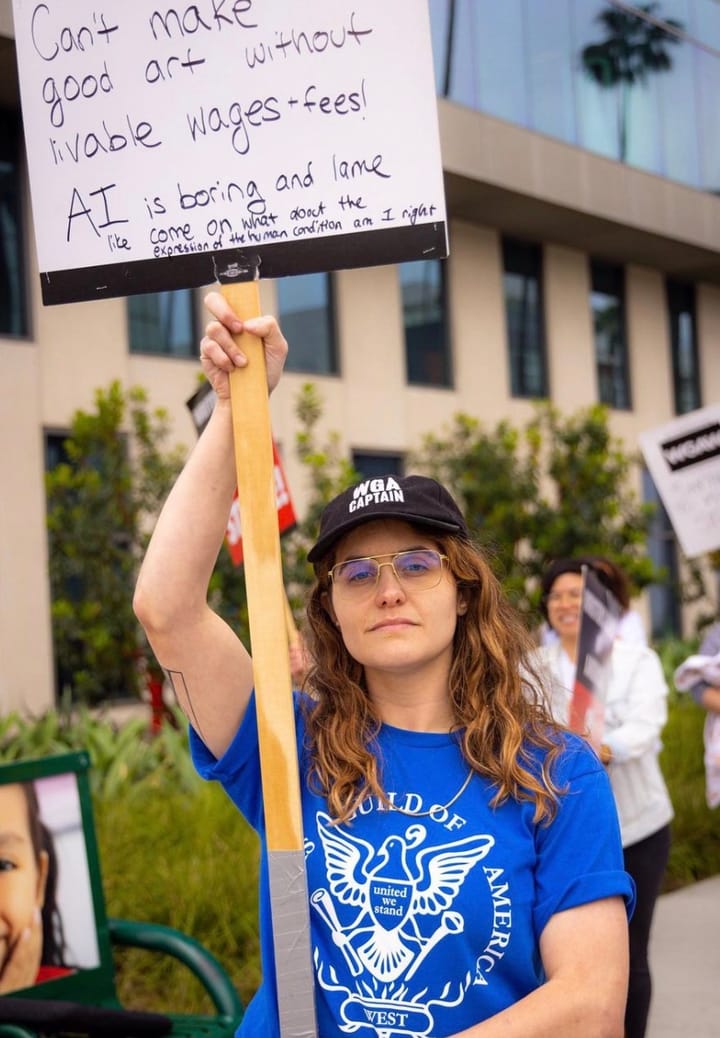

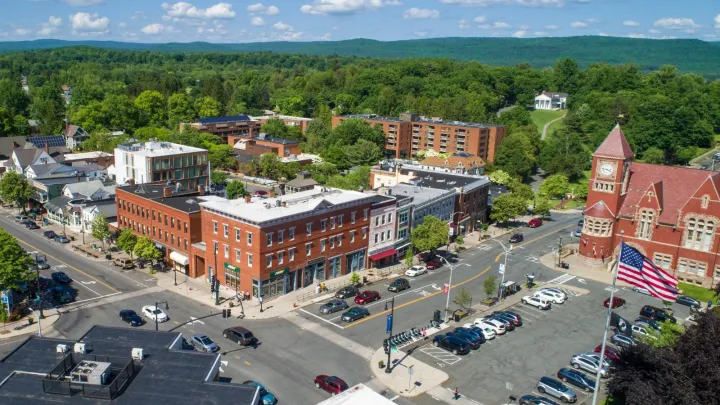
Comments ()